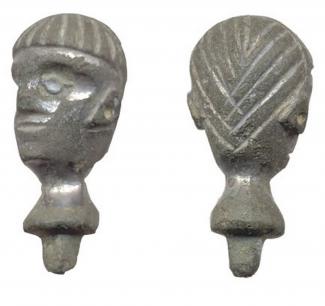Roman copper-alloy hairpin head in the form of a male head, about 1st-4th Century AD, found at Ovington, Itchen Stoke and Ovington, Hampshire. Cool, Group 18, sub-group A. At the top of the object the hair is represented. There is a lateral line across the forehead above which the hair at the front of the head is represented. There is a lateral incised groove across the top of the head and a vertical groove down the centre, dividing the front part of the hair into two sections. Within each section there are a series of transverse grooves. At the back of the head there are two straight transverse grooves, each beginning at the either end of the lateral line across the forward and meeting just above the neck, which define the hair at the back of the head. There are a series of opposing transverse grooves, parallel to the defining grooves, which begin at the lateral groove across the top of the head and meet in the centre of the back of the head, sometimes overlapping. The face is recessed slightly from the hair. The eyes are represented as circular recesses with a raised central dot. The nose is a crude raised triangle, and the mouth is represented by two lateral grooves separated by a ridge. The ears are also raised triangles, with a central circular recess. Beneath the head the object is waited to form the neck before ending in a flat circular terminal from which a short rectangular sectioned shaft projects. Considerable white metal coating remains on all surfaces, except for the shaft, particularly at the front. Mid-green patina.
Hairpin head in the form of a male head
Roman
Found with a metal detector at Ovington, Hampshire
A pin head made from copper-alloy coated in silver in the form of a male human head. A face from the past stares back at you, albeit a stylised one. Particularly distinctive is the man's hair which has a 'pudding-basin' cut at the front and is styled into a succession of 'V's travelling down the back. Could this have been the trendy hair cut of its day?
Portable Antiquities Scheme find number HAMP-1E6536.



